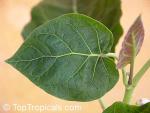 |
Genus of about 30 species of perennials and evergreen shrubs, trees and climbers from the margins of dry forest in tropical Africa.
The tamarillo is a subtropical rather than tropical and flourishes between 5,000 and 10,000 ft. in its Andean homeland. In cooler climates it succeeds at lower elevations, but does best where the temperature remains above 50° F. The plant is grown casually in California and occasionally in Florida. Protection from wind is necessary as the tree is shallow rooted and easily blown over. It is also brittle and its branches are easily broken by gusts, especially when laden with fruit. Tamarillos have been grown as housesplants for years. They fruit satisfactorily in northern greenhouses.
The tamarillo is a small, attractive, half-woody, evergreen or partially deciduous, shrub or small tree. It is also brittle and shallow-rooted, growing to a height of 10 to 18 ft. (rarely as much as 25 ft.). The fragrant 1/2 to 3/4 inch flowers are borne in small, loose clusters near the branch tips. They have 5 pale pink or lavender, pointed lobes, 5 prominent yellow stamens and green-purple calyx. Tamarillo flowers are normally self-pollinating. If wind is completely cut off so as not to stir branches, this may adversely affect pollination unless there are bees to transfer the pollen. Unpollinated flowers will drop prematurely. Flowers are usually borne in late summer or fall, but may appear at any time.
The long-stalked, dangling fruit, borne singly or in clusters of 3 to 12, is smooth egg-shaped but pointed at both ends. It ranges in size from 2 to 4 inches long and 1-1/2 to 2 inches in width. Skin color may be solid deep purple, blood red, orange or yellow, or red and yellow, and may have faint dark longitudinal stripes. Flesh color varies accordingly from orange-red or orange to yellow or cream-yellow. While the skin is somewhat tough and unpleasant in flavor, the outer layer of the flesh is slightly firm, succulent and bland, and the pulp surrounding the seed in two lengthwise compartments is soft, juicy, and sweet/tart. The yellow types are usually a little sweeter. The pulp is black in dark purple and red fruits and yellow in yellow and orange fruits. The edible seeds are thin, nearly flat, circular, larger and harder than those of the true tomato.
The fruits are juicy and sub-acid, they are eaten out of hand, added to salads, used in preserves, jams, jellies etc. |
 |


